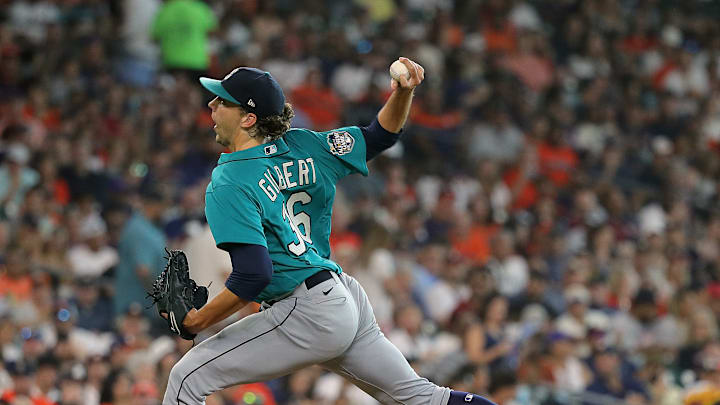In his first two years with Seattle, Gilbert’s standout pitch was his four-seam fastball, accumulating run value figures of 19 and 12 in 2021 and 2022 specifically. While he depended on it for more than half of his pitches, his toolkit of breaking balls was sparse and underdeveloped, resulting in him often giving up hard contact.
This year, things are different. His average four-seam velocity is still above average at 95.6 mph but he’s slowly started to increase his portion of sliders and splitters. Furthermore, his slider has a run value of 11 this year as opposed to 0 in 2022 and a paltry -9 in 2021. If you’ve watched him pitch at all this season, you know that the pitch is absolutely devastating.
How The Pitch Has Changed
Every aspect of the pitch has improved significantly since last season.
Velocity (MPH) | Whiff% | PutAway% | Vertical Drop (Inches) | Horizontal Break (Inches) | |
|---|---|---|---|---|---|
2023 | 88.7 | 32.1 | 23.6 | 34.1 | 0.8 |
2022 | 86.9 | 25.1 | 16.3 | 31.6 | 6.1 |
It seems that the main driver behind a notable increase in Whiff% is the added velocity and the decision to reshape the pitch to drop downwards instead of breaking inwards, more akin to a sweeper. In this at-bat against Marcus Semien, the high velocity and late break towards his kneecaps makes it difficult for even a talented hitter to take or make contact with.
Logan Gilbert, Dirty 90mph Slider. 😨
— Rob Friedman (@PitchingNinja) May 9, 2023
7th consecutive K pic.twitter.com/Q4lzOVsJYl
With other hitters, he’ll incorporate some lateral movement to get the pitch off the plate but will still get the pitch below the strike zone to reduce any hard contact. Without the downward movement, it’s possible Sean Murphy would have gotten a hit off the end of his bat and put the ball in play. Instead, he gives his best Javy Baez impression.
Logan Gilbert, Wicked 87mph Slider. 🤢 pic.twitter.com/TtUdRpXQiW
— Rob Friedman (@PitchingNinja) May 21, 2023
Why Such A Difference In Run Value?
While the intrinsic qualities of the pitch have moved in the right direction, the actual results look about the same on paper. In fact, his slider's wOBA has actually increased from .256 to .261 implying that hitters are actually performing slightly better against the pitch compared to last year.
It’s times like this that demonstrate the importance of what stats actually mean and what they are trying to tell us. While it’s meant to be a single figure that roughly gauges the effectiveness of a given pitch, its ultimate driving factor is runs scored or prevented. For example, a solo home run and a grand slam have the same BA, SLG, and OPS value, but they are two very different scoring events and thus contribute very differently to run-scoring.
Using a surprisingly simple tool called the run expectancy matrix, analysts can calculate the number of expected runs based on the runners on base and the number of outs, often called the base-out state. Because this is based on expected runs, it’s also affected by league-wide offensive performance, so a season with more prolific hitting would assign a higher run value to a pitch with the same wOBA as one thrown in a season with deflated offense.
2022 Triple-A run expectancy matrix (RE24): pic.twitter.com/ObwNupX5vZ
— Sam Wirth (@SamWirthSports) August 8, 2022
While the above Tweet is for the 2022 AAA season, you can see how the expected run value changes drastically depends on the current state of the game.
Like WAR, OAA, and UZR, the run value statistic can seem immensely contrived and other than bickering with your uncle who swears that Derek Jeter is the best player to ever swing a bat, it seems somewhat pointless. We know that the slider has a much higher run value but what does that really mean?
It means several things. First and foremost, it’s being used more successfully in higher leverage situations (runners in scoring position, fewer outs, etc.). Second, it’s putting up similar rate statistics in one of the most hitter-friendly seasons in recent memory. The league-average OPS in 2023 is .736, significantly higher than last year’s figure of .706. Thus, while it may seem to be the same pitch, it’s a big reason why Gilbert continues to be one of the most underrated pitchers in the American League.
